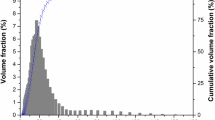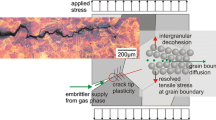Abstract
The use of X-ray residual stress determination as a technique for evaluating the damage incurred by nickel-based, Cr2O3-forming superalloy materials under various service conditions (isothermal heating, thermal cycling, applied stress, stressed and cycled) was investigated. Large and small compressive residual stresses were observed for the oxides and the near surface substrates, respectively. It was expected that the applied stresses and thermal cycling would cause an enhanced degree of oxidation damage that would translate into appreciable differences in residual stress values. Differences in the magnitude of residual stress values were not appreciable condition-to-condition, however. An increase in the severity of the oxidizing conditions in the form of longer oxidation times, higher oxidizing temperatures, and a much greater frequency of thermal cycling is suggested for future studies.






Similar content being viewed by others
Notes
Materials Data, Inc., (MDI), Livermore, California 94550.
References
J. H. Chen, P. M. Rogers, and J. A. Little, Oxidation of Metals 47, 381 (1997).
W. Z. Friend, Corrosion of Nickel and Nickel-Base Alloys, (John Wiley and Sons, New York, 1980), p. 166.
N. Hussain, K. A. Shalid, I. H. Khan, and S. Rahman, Oxidation of Metals 43, 363 (1995).
F. A. Khalid and S. E. Benjamin, Oxidation of Metals 54, 63 (2000).
S.-B. Kim, A. Evans, J. Shackleton, G. Bruno, M. Preuss, and P. J. Withers, Metallurgical and Materials Transactions A 36A, 3041 (2005).
H. J. Grabke, R. Dennert, and B. Wagemann, Oxidation of Metals 47, 495 (1997).
H. E. Evans, International Materials Reviews 40, 1 (1995).
B. Gleeson and M. A. Harper, Oxidation of Metals 49, 373 (1998).
H. Buscail, Y. P. Jacob, M. F. Stroosnijder, E. Caudron, R. Cueff, F. Rabaste, and S. Perrier, Materials Science Forum 461–464, 93 (2004).
D. J. Srolovitz and T. A. Ramanarayanan, Oxidation of Metals 22, 133 (1984).
P. Pagliaro, M. B. Prime, B. Zuccarello, B. Clausen, and T. R. Watkins, in Experimental Analysis of Nano and Engineering Materials and Structures: Proceedings of the 13th International Conference on Experimental Mechanics (ICEM13), Alexandroupolis, Greece, July 1–6, 2007, paper no. 246, CD-ROM. eds. by E. E. Gdoutos (Springer, 2007).
S. J. Bull, Oxidation of Metals 49, 1 (1998).
M. Khadhraoui, W. Cao, L. Castex, and J. Y. Guedo, Materials Science and Technology 13, 360 (1997).
W. Cao, M. Khadhraoui, B. Brenier, J. Y. Guedo, and L. Castex, Materials Science and Technology 10, 947 (1994).
D. L. Douglass, P. Kofstad, A. Rahmel, and G. C. Wood (eds.), Subject Area 8: Behavior of Scales Under Mechanical Loading (Oxidation of Metals, 45, 529, 1996).
A. Rahmel, G. C. Wood, P. Kofstad, and D. L. Douglass (eds.) Subject Area 9: Interaction Between Oxidation (Sulfidation, Carburization) and Creep (Oxidation of Metals, 23, 251, 1985).
G. Calvarin-Amiri, R. Molins, and A. M. Huntz, Oxidation of Metals 54, 399 (2000).
A. Schnass and H. J. Grabke, Oxidation of Metals 12, 387 (1978).
C. Mathieu and S. Toesca, Oxidation of Metals 39, 155 (1993).
D. Poquillon and D. Monceau, Oxidation of Metals 59, 409 (2003).
Haynes Website, www.haynesintl.com.
O. Kubaschewski and B. E. Hopkins, Oxidation of Metals and Alloys, 2nd edn. (Butterworth and Co. Ltd., London, 1962), p. 35.
B. Pieraggi, Oxidation of Metals 27, 177 (1987).
H. Krause and A. Haase, in Experimental Techniques of Texture Analysis, ed. H. J. Bunge (DGM Informationsgesellschaft Verlag, Oberursel, 1986), p. 405.
I. C. Noyan and J. B. Cohen, Residual Stress, Measurement by Diffraction and Interpretation (Springer-Verlag, New York, 1987).
T. R. Watkins, O. B. Cavin, J. Bai, and J. A. Chediak, in Advances in X-Ray Analysis, Vol. 46 CD ROM, eds. T. C. Huang et al. (ICDD, Newtown Square, PA, 2003), p. 119.
P. Rudnik and J. B. Cohen, in Advances in X-Ray Analysis, eds. J. B. Cohen et al., Vol. 29 (Plenum Press, NY, 1985), p. 79.
P. F. Tortorelli, Journal de Physique IV 3, 943 (1993).
N. Birks and G. H. Meier, Introduction to High Temperature Oxidation of Metals (Edward Arnold (Publishers) Ltd., London, 1983), pp. 108, 118.
J. G. Goedjen, J. H. Stout, Q. Guo, and D. A. Shores, Materials Science and Engineering A177, 115 (1994).
Y. Zhang and D. A. Shores, Oxidation of Metals 40, 529 (1993).
Y. Zhang, W. W. Gerberich, and D. A. Shores, Journal of Materials Research 12, 697 (1997).
A. M. Huntz, Materials Science and Engineering A201, 211 (1994).
M. Kemdehoundja, J. F. Dinhut, J. L. Grosseau-Poussard, and M. Jeannin, Materials Science and Engineering A 435–436, 666 (2006).
D. Zhu, J. H. Stout, and D. A. Shores, Materials Science Forum 251–254, 333 (1997).
S. Daghigh, J. L. Lebrun, and A. M. Huntz, Materials Science Forum 251–254, 381 (1997).
A. M. Huntz, S. Daghigh, A. Piant, and J. L. Lebrun, Materials Science and Engineering A248, 44 (1998).
P. Y. Hou, A. P. Paulikas, and B. W. Veal, Materials Science Forum 461–464, 671 (2004).
B. W. Veal, A. P. Paulikas, B. Gleeson, and P. Y. Hou, Surface & Coatings Technology 202, 608 (2007).
B. W. Veal, A. P. Paulikas, and P. Y. Hou, Applied Physics Letters 90, 121914-1–121914-3 (2007).
A. V. Virkar, J. L. Huang, and R. A. Cutler, Journal of the American Ceramic Society 70, 164 (1987).
J. F. Schmitt, N. Pacia, P. Pigeat, and B. Weber, Oxidation of Metals 44, 429 (1995).
B. R. Barnard, M. S. Thesis, University of Tennessee, Knoxville, USA (2008).
B. R. Barnard, P. K. Liaw, R. A. Buchanan, and D. L. Klarstrom, Materials Science and Engineering A 527, 3813 (2010).
B. D. Cullity, Elements of X-Ray Diffraction, 2nd edn. (Addison-Wesley Publishing Company, Inc., Reading, 1978), pp. 132, 292.
Acknowledgements
The samples were provided by Dr. D. L. Klarstrom of Haynes International, Inc., Kokomo, IN. The authors appreciate the advice and aid of Drs. P. Tortorelli, B. Pint, E. Lara-Curzio, W. Ren, R. Swindeman, W. Kai, Y. Lu, M. Morrison, W. H. Peter, R. Steward, M. Benson, B. Green, M. Freels, and R. A. Buchanan. The author is grateful for the help and advice of Mr. M. Neal, Mr. G. Jones, Mr. F. Holiway, Mr. R. Stookesbury, Mr. S. White, Mr. K. Johanns, Mr. J. Shingledecker, Mr. C. Stephens, Mr. K. Kubushiro, Mr. R. Mcdaniels, Mr. A. Chuang, Ms. S. Maples, Ms. C. Lawrence, Ms. C. Winn, Ms. R. Cook, Mr. D. Fielden, and the University of Tennessee machine shop. The authors gratefully acknowledge the financial support from the National Science Foundation (NSF), the Integrative Graduate Education and Research Training (IGERT) Program, under DGE-9987548, DMR-0909037, and CMMI-0900271 to the University of Tennessee (UT), Knoxville, with Drs. C. J. Van Hartesveldt, J. D. Giordan, D. Dutta, L. Clesceri, W. Jennings, L. Goldberg, A. Ardell, and C. V. Cooper as contract monitors, respectively. Portions of this research were conducted at the Oak Ridge National Laboratory’s High Temperature Materials Laboratory User Program sponsored by the U. S. Department of Energy, Office of Energy Efficiency and Renewable Energy, Vehicle Technologies Program. Portions of this research were sponsored by the Industrial Technologies Program, Industrial Materials for the Future Program, Materials Processing Laboratory Users Project, Oak Ridge National Laboratory. Both programs are managed by UT-Battelle, LLC, for the U. S. Department of Energy under contract number DE-AC05-00OR22725. This manuscript has been authored by UT-Battelle, LLC, under Contract No. DE-AC05-00OR22725 with the U.S. Department of Energy. The United States Government retains and the publisher, by accepting the article for publication, acknowledges that the United States Government retains a non-exclusive, paid-up, irrevocable, world-wide license to publish or reproduce the published form of this manuscript, or allow others to do so, for United States Government purposes.
Author information
Authors and Affiliations
Corresponding author
Additional information
Disclaimer
This document was prepared by Bryan Barnard as a result of the use of facilities of the U. S. Department of Energy (DOE) that are managed by UT-BATTELLE, LLC. Neither UT-BATTELLE, LLC, DOE, or the U. S. government, nor any person acting on their behalf: (a) makes any warranty or representation, express or implied, with respect to the information contained in this document; or (b) assumes any liabilities with respect to the use of, or damages resulting from the use of, any information contained in the document.
Rights and permissions
About this article
Cite this article
Barnard, B.R., Watkins, T.R. & Liaw, P.K. An Evaluation of the Use of X-ray Residual Stress Determination as a Means of Characterizing Oxidation Damage of Nickel-Based, Cr2O3-Forming Superalloys Subjected to Various Oxidizing Conditions. Oxid Met 74, 305–318 (2010). https://doi.org/10.1007/s11085-010-9214-6
Received:
Revised:
Published:
Issue Date:
DOI: https://doi.org/10.1007/s11085-010-9214-6




